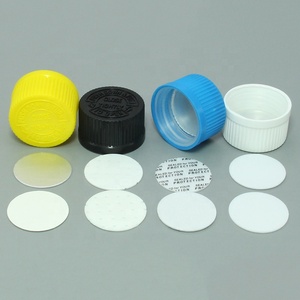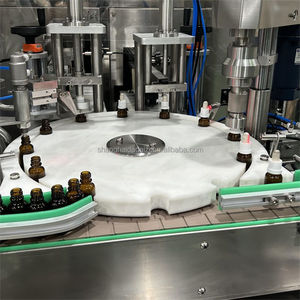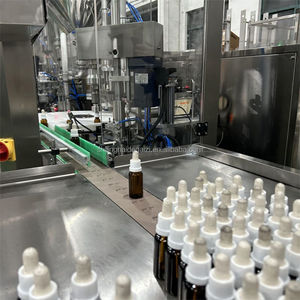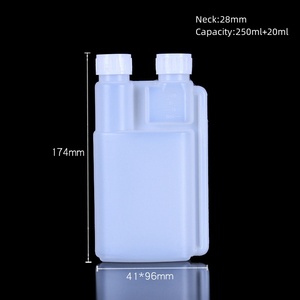
All categories
Featured selections
Trade Assurance
Buyer Central
Help Center
Get the app
Become a supplier

(3722 products available)







































Liquid dosing bottles are available in various forms and serve a wide range of purposes. Below are the most common types of these containers:
Measurement Bottles
These bottles come with graduations or measuring scales. Thus, they are ideal for serving and pouring. The bottle's body is made of glass or crystal, which enables clear visibility. It also allows for accurate measuring of liquids such as spices, oil, or liquor. These bottles also have a tight-sealing stopper. This helps keep the contents fresh and prevents spillage.
Drops Bottles
Droppers allow liquid to dispense in small and measured drops. This makes it an ideal choice for thick or viscous substances such as essential oils, medicines, or eye drops. Most drops bottles are made from glass or plastic. Glass, however, is the preferred choice since it works best to preserve the purity of the contents. These bottles have well-sealed dropper caps. This keeps the liquid inside safe from contamination and evaporation.
Spray Bottles
Spray bottles are used to dispense liquids in a fine mist or spray form. This makes them suitable for use with cleaning solutions, perfumes, and water for hair styling. Spray bottles are usually made from durable plastic. They also come equipped with a pump mechanism that allows for adjustable spray settings. This helps control the amount of liquid released.
The Pipette Dosing Bottles
Pipette dosing bottles come fitted with a pipette dropper. This makes them ideal for precise liquid measurements and transfers. These bottles are mostly used in laboratories for chemicals and reagents. They are also commonly found in the pharmaceutical and cosmetic industries. The pipette's airtight seal ensures accurate doses without waste or spillage.
Vacuum Insulated Dosing Bottles
These bottles are designed to keep liquids hot or cold for longer periods. They are ideal for coffee, tea, or other beverages that need temperature control. Vacuum insulated bottles are made with stainless steel and have a double-walled construction.
Plastic dosing bottles come in different designs to suit specific needs, preferences, and aesthetics. These design variations are mainly based on the types of closures, shapes, label placements, and additional features. Some of these features include protective caps and measuring devices. Below are the most common designs:
Child-Resistant Cap Dosing Bottles
These bottles come with a child-proof cap. It ensures safety when using potentially hazardous liquids such as medicines, chemicals, or poisitions. These caps are hard for children to open but straightforward for adults. These bottles are essential in the pharmaceutical industry and for dangerous household products.
Tamper-Evident Cap Dosing Bottles
These bottles have screw caps and snap-on lids. These features provide a visual cue of whether a liquid has been altered. This makes it especially appropriate for food and drug products. These caps also improve safety by ensuring that only properly sealed containers are used.
Nozzle Caps Dosing Bottles
These bottles have narrow caps through which liquids pass. This helps control their flow and is mostly used in the food, cosmetic, and chemical sectors. The bottle nozzles allow precise liquid dispensing in smaller amounts. This reduces waste and improves application.
Measuring Cap Dosing Bottles
These bottles integrate graduated caps. This allows users to measure and dispense the right liquid amounts. It is particularly useful for pharmaceuticals, cooking oils, and cleaning products. It ensures proper dosage.
Recycling Dosing Bottles
These bottles are manufactured with recyclable materials. PETE or HDPE support sustainable practices. These bottles are retaken into the standard after use. This helps minimize environmental pollution caused by plastics. This design reduces overall carbon footprint while promoting eco-friendly initiatives.
Several factors come into play when choosing the right liquid dosing bottle. Below are some of these factors:
Material
Bottles are made from either plastic, glass, or metal. Each material has its pros and cons, depending on the liquid it will hold. Plastics are normally unbreakable and relatively inexpensive. This makes them an excellent choice for general use. On the other hand, glass is non-reactive and ideal for storing chemicals or pharmaceuticals. Metal bottles are robust and good for storing oils or liquors.
Dosing Precision
The dosing bottle's design must allow precise liquid dispensing. This is critical in industries where exact measurements are necessary, like in the pharmaceutical and cosmetic industries. Look for features that improve measurement accuracy. Examples are marked graduations or anti-priming tips.
Sustainability and Reusability
Sustainability has become a very important factor in many people's lives. Consideration should be given to the environmental impact of the bottle and its materials. Choose bottles manufactured from biodegradable plastics or recyclable glass. If applicable, reusability should also be taken into account. It is because this can significantly lower waste over a product's lifespan.
Compatibility with Liquid
One must ensure that the chosen liquid dosing bottle is compatible with the type of liquid it is intended to store. It is because some chemicals can degrade certain plastics, leading to contamination or loss of integrity. It is vital to consult manufacturers' recommendations to avoid this from happening.
Ease of Use
Assessing the bottle's usability in practice is important. Focus should go on the nozzle design, cap types, and ergonomic shapes. These elements can ensure easier handling and smoother operations. These factors should be accounted for, especially in settings with high throughput or where user comfort is essential.
The manufacturing process of liquid dosing bottles involves several key steps. They range from material selection to final quality checks. Below is a breakdown of these process steps:
Material Selection
The first step of manufacturing liquid dosing bottles is choosing the right materials. Commonly used materials include glass and various plastics such as polyethylene terephthalate (PET), high-density polyethylene (HDPE), and polypropylene (PP). Each of these materials has unique properties. These properties make them suitable for different applications. For instance, glass is usually used when storing chemicals that might break down plastic. Conversely, each plastic has its advantages. For instance, PET is lightweight, while HDPE is impact-resistant.
Molding
The primary manufacturing method for plastic dosing bottles is injection or blow molding. This molding process involves heating the selected plastic resins until they become pliable. Afterward, the heated plastics are injected into molds that have been designed to form the desired bottle shape. In blow molding, air pressure is used to expand the plastic within the mold. This process provides a more uniform wall thickness and a lighter final product, improving usability.
Quality Control
Manufacturers have to carry out quality control at every stage of production. They mostly conduct inspections to check for defects in the molding process. These defects can be cracks, uneven surfaces, or misaligned nozzles. Before the bottles are filled, manufacturers also conduct tests to examine how strong and durable they are. This is usually done by applying pressure to the bottles. Sometimes, they also test the bottles' compatibility with various liquids to ensure they will not react with the contents.
Filling and Packaging
After performing quality checks, the bottles are then filled with the appropriate liquid. The filling process is automated. During packaging, manufacturers ensure that each bottle is sealed properly. They also package similar bottles together to enhance efficiency during distribution.
A1: While both types of dosing bottles serve the same purpose, they differ in various ways. One of the most notable differences is that plastic bottles are unbreakable, making them safer in many environments. On the other hand, glass bottles are breakable but better suited for storing chemicals and pharmaceuticals, as they are often more chemically resistant. Plastic bottles are also lighter and cheaper than glass bottles. On the other hand, although glass is more expensive and heavier, it frequently provides a more sterile and premium appearance.
A2: This mainly depends on the material and design of the liquid dosing bottle. Glass dosing bottles, in particular, can be washed and reused several times. Plastic dosing bottles may also be reusable, but this is often only the case with specifically designed ones made from durable plastics like HDPE or PET.
A3: Different materials are used for manufacturing liquid dosing bottles for different applications. For example, glass is commonly chosen for pharmaceuticals and chemicals because of its impermeability and chemical resistance. Plastic, on the other hand, is generally more affordable and practical due to its durability, lighter weight, and break resistance.
A4: Liquid dosing bottles come in a wide range of capacities. These range from very small bottles intended for pharmaceutical applications, such as eye drops, to much larger industrial containers. For example, they are as large as a few milliliters to several liters.
A5: Several factors affect the precision of liquid dosing bottles. One of them is the material's surface tension. Another factor is ergonomics, which manufacturing considers in the design of the contoured bodies and caps with easy grip. Measuring features like graduated dropper caps or piston-driven pumps also improve accuracy.